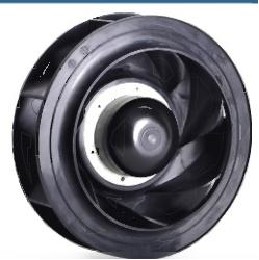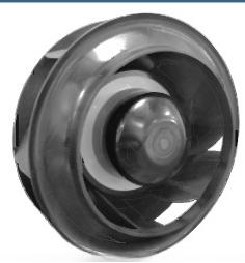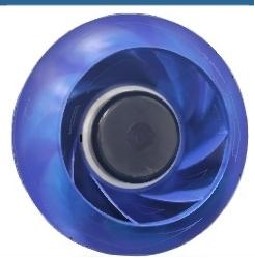DC Backward Centrifugal Fans: The Unsung Heroes of Modern Airflow Dynamics

The Engineering Marvel of DC Backward Centrifugal Fans in Modern Industry
As a Chief Product Engineer with over 15 years immersed in the intricate world of industrial fans and motors, I’ve seen the landscape of airflow management transform dramatically. What was once a simple task of moving air has evolved into a highly specialized field demanding precision, efficiency, and intelligence. At the forefront of this evolution are DC Backward Centrifugal Fans, a class of fan that, in my experience, consistently delivers superior performance and long-term value across a multitude of complex industrial applications. These aren't just components; they are critical engineered solutions.
The fundamental appeal of DC Backward Centrifugal Fans lies in their unique aerodynamic design. Unlike radial or forward-curved fans, the blades of a backward centrifugal fan curve away from the direction of rotation. This seemingly subtle difference has profound implications for performance. Over the years, I've learned that this design makes them inherently non-overloading, meaning their power consumption does not drastically increase even as the system static pressure decreases. This characteristic is invaluable in real-world industrial settings where operating conditions can fluctuate widely, preventing motor overload and extending equipment lifespan. This design also contributes to their superior efficiency, as air exits the impeller with higher kinetic energy, converting more effectively into static pressure.
Understanding the Efficiency Edge of DC Backward Centrifugal Fans
When discussing DC Backward Centrifugal Fans, energy efficiency is a non-negotiable topic. In an era where energy costs and sustainability are paramount, the choice of fan technology directly impacts a company's bottom line and environmental footprint. The core of their efficiency stems from the marriage of their aerodynamic design with advanced DC motor technology.
Unlike conventional AC motors, DC motors, particularly electronically commutated (EC) motors often found in these fans, offer unparalleled control and higher intrinsic efficiency. In my experience, the ability to precisely control the fan speed of DC Backward Centrifugal Fans allows systems to operate only at the required airflow, avoiding the constant, energy-wasting full-speed operation of many AC counterparts. This variable speed capability means significant energy savings, especially in applications with fluctuating demand. Our firm commitment to the R&D and production of energy-saving, high-tech products is evidenced by our fans meeting the stringent ERP2015 standard, a testament to their low power consumption. This isn't just about compliance; it's about engineering products that genuinely reduce operational costs for our clients, aligning with global energy efficiency initiatives promoted by bodies like the International Energy Agency (IEA).
The Quiet Power: Noise Reduction in DC Backward Centrifugal Fans
Industrial environments are often synonymous with noise, which can be detrimental to worker health, productivity, and even compliance with occupational safety regulations. One of the less-talked-about but highly significant advantages of DC Backward Centrifugal Fans is their inherently lower noise profile compared to other fan types operating at similar performance levels.
The aerodynamic efficiency that contributes to energy savings also plays a crucial role in noise reduction. The smoother airflow path created by the backward-curved blades minimizes turbulence and eddy currents, which are major sources of fan noise. Furthermore, the precise electronic control offered by DC motors allows for smoother operation, reducing mechanical vibrations and acoustic output. For example, our φ220 DC Backward Centrifugal Fans operate at a sound level of 65 dB. While 65 dB might still sound significant to the uninitiated, in many industrial contexts, this represents a substantial reduction from typical fan noise, contributing to a more agreeable working environment. As a Chief Product Engineer, I always emphasize that addressing noise pollution is not just a regulatory obligation, but a mark of a well-engineered and human-centric industrial solution.
Durability and Reliability: The Build of DC Backward Centrifugal Fans
The demands of industrial environments are relentless. High temperatures, corrosive atmospheres, dust, and continuous operation require components that are not just efficient but exceptionally durable. This is a critical aspect where DC Backward Centrifugal Fans excel, thanks to thoughtful material selection and robust manufacturing processes.
For our φ220 DC Backward Centrifugal Fans, we utilize high-quality PA66 material. In my years of working with various polymers, PA66 stands out for its superior mechanical strength, stiffness, and excellent resistance to wear and fatigue. This makes it an ideal choice for fan impellers that endure constant rotational stress and potential abrasive particles in the airstream. Furthermore, the material's chemical resistance ensures longevity even when exposed to certain industrial fumes or cleaning agents.
Beyond the material, the overall construction and protection rating are vital. Our DC Backward Centrifugal Fans typically boast an IP42 protection rating, meaning they are protected against solid objects larger than 1mm and splashing water. This level of ingress protection is crucial for industrial fans that might be exposed to dust, moisture, or cleaning processes. This robust construction, combined with comprehensive certifications like CCC and CE, underscores a commitment to reliability that, as a product engineer, I know is essential for operational continuity and minimizing downtime. These certifications aren't just labels; they represent adherence to rigorous safety and quality standards that ensure a product is fit for purpose in demanding applications.
DC Backward Centrifugal Fans in Action: Key Applications and Innovations
The versatility and performance of DC Backward Centrifugal Fans make them indispensable across a wide array of industrial sectors. From large-scale HVAC systems to specialized equipment cooling, their advantages are clear.
- Industrial Ventilation Systems: They are the backbone of efficient factory ventilation, ensuring proper air changes, removing heat, and exhausting contaminants.
- HVAC Systems: In commercial buildings and large industrial complexes, they provide precise airflow for climate control, crucial for both human comfort and equipment integrity.
- Refrigeration Units: In cold storage and refrigeration, their consistent, energy-efficient airflow helps maintain stable temperatures, critical for perishable goods.
- Telecom Cabinets: Their compact design and efficient cooling capabilities are vital for preventing overheating in dense electronic enclosures.
- Food Processing: Here, the need for clean, consistent airflow in controlled environments makes DC Backward Centrifugal Fans a preferred choice due to their reliability and hygienic material options.
A significant innovation that has further elevated the status of DC Backward Centrifugal Fans is the development of DC constant air volume fan technology. In my career, this has been a game-changer. This technology allows the fan to maintain a pre-set airflow volume regardless of changes in system static pressure, which can occur due to filter loading or duct adjustments. This level of precise control is invaluable in applications like cleanrooms, laboratories, and specialized manufacturing processes where consistent air change rates are absolutely critical. It demonstrates our commitment to pushing the boundaries of what these fans can achieve.
Parameters for Precision: Key Specifications of DC Backward Centrifugal Fans
While the technical principles are crucial, understanding the practical specifications is equally important for integration. For our φ220 series of DC Backward Centrifugal Fans, key parameters include:
- Fan Diameter: φ220 mm
- Typical Voltage Options: 24V DC, 48V DC (offering flexibility for diverse industrial power supplies)
- Material Construction: High-quality PA66
- Protection Rating: IP42
- Acoustic Profile: Low Noise Operation at 65 dB
- Compliance: CCC and CE certified
- Energy Efficiency Standard: Designed to meet ERP2015
Choosing the Right DC Backward Centrifugal Fans: A Purchasing Guide
When you're looking to integrate DC Backward Centrifugal Fans into your systems, several considerations are paramount to ensure you make the right investment. As a Chief Product Engineer who has guided countless clients, I'd emphasize these points:
Firstly, energy efficiency is non-negotiable. Always check for compliance with standards like ERP2015. This directly translates to lower operational costs over the fan's lifespan. Secondly, durability and material selection are key. Ensure the fan's construction materials (like PA66) and IP rating are suitable for your operating environment. Thirdly, consider the noise profile. A lower dB rating contributes to a better working environment. Lastly, assess the manufacturer's technical capabilities and support. Look for companies with strong R&D, patent portfolios, and technical cooperation with reputable institutions. This signals a commitment to quality and innovation that will serve you well in the long run.
Ready to Elevate Your Airflow with DC Backward Centrifugal Fans?
If you're seeking to optimize your industrial ventilation, cooling, or process airflow, our DC Backward Centrifugal Fans offer a compelling solution. Explore our full range of intelligent, energy-saving fans designed for complex working points.
Contact our expert engineering team today to discuss your specific requirements, receive a personalized consultation, or request a detailed quote. Let's work together to engineer the optimal airflow solution for your operations.
DC Backward Centrifugal Fans FAQ
Q: What safety certifications do AFL's φ220 DC Backward Centrifugal Fans have?
A: Our DC Backward Centrifugal Fans φ220 are rigorously tested and certified by CCC (China Compulsory Certification) and CE (Conformité Européenne). These certifications confirm that our fans meet stringent national and European safety, health, and environmental protection standards, ensuring their safe and reliable deployment in industrial applications.
Q: Can you explain the warranty policy for your DC Backward Centrifugal Fans?
A: AFL offers a robust warranty policy for our DC Backward Centrifugal Fans, typically covering manufacturing defects and material failures for a period of [Insert specific warranty period, e.g., 1-2 years] from the date of purchase. Our goal is to provide our customers with peace of mind and confidence in the longevity and performance of our products. Detailed terms are available upon request or in the product documentation.
Q: What is the quality control process for manufacturing AFL's DC Backward Centrifugal Fans?
A: Our manufacturing of DC Backward Centrifugal Fans involves a comprehensive, multi-stage quality control process. This begins with stringent raw material inspection, followed by continuous in-process checks during assembly. Every single fan undergoes rigorous final performance testing, including measurements of airflow, pressure, power consumption, and noise levels in our advanced testing facilities. This meticulous process ensures that each fan meets our high standards for quality, efficiency, and reliability.
Q: How do DC Backward Centrifugal Fans achieve their high energy efficiency?
A: DC Backward Centrifugal Fans achieve high energy efficiency through a powerful combination of their inherent backward-curved blade design and the advanced technology of electronically commutated (EC) DC motors. The blade geometry optimizes airflow and reduces turbulence, while the EC motors provide precise speed control and operate with significantly less power loss compared to traditional AC motors, ensuring that they meet or exceed standards like ERP2015.
Q: What are the primary applications for DC Backward Centrifugal Fans?
A: DC Backward Centrifugal Fans are ideal for a wide range of industrial applications requiring efficient and controlled airflow. Key uses include industrial ventilation systems, precise HVAC applications, refrigeration and cold storage units, data center cooling, telecom equipment cooling, and various food processing and manufacturing environments where consistent and energy-efficient air movement is critical.
Q: How does the PA66 material enhance the durability of these fans?
A: The use of PA66 (Polyamide 66) in our DC Backward Centrifugal Fans significantly enhances their durability. PA66 is a high-performance engineering plastic known for its exceptional mechanical strength, stiffness, wear resistance, and fatigue endurance. This makes it perfectly suited for fan impellers that are subjected to continuous rotational stress and potential abrasion from airborne particles, ensuring a long operational lifespan even in harsh industrial conditions.
Q: Is the 65 dB noise level of the φ220 DC Backward Centrifugal Fans suitable for all industrial settings?
A: The 65 dB noise level for our φ220 DC Backward Centrifugal Fans represents a commendably quiet operation for industrial applications, often a significant improvement over many conventional industrial fans. While suitable for many environments, for highly noise-sensitive areas or spaces with very strict occupational noise limits, additional acoustic mitigation measures or specific system designs might be considered. We always recommend assessing your specific operational environment to determine the optimal noise solution.
Q: What are the advantages of offering both 24V and 48V voltage options for these fans?
A: Providing both 24V and 48V DC voltage options for our DC Backward Centrifugal Fans offers significant versatility for industrial integration. This flexibility allows our fans to be seamlessly incorporated into a broader array of existing electrical power infrastructures, simplifying installation and potentially reducing the need for additional power conversion equipment, making them highly adaptable across different industrial machinery and systems.
Q: How does AFL maintain a leading technology level in China for its fans, particularly DC Backward Centrifugal Fans?
A: AFL ensures its leading technology level in China for fans, including DC Backward Centrifugal Fans, through substantial and continuous R&D investment, strategic technical cooperation with top scientific research institutes like Zhejiang University and the Institute of Electrical Engineering of Chinese Academy of Sciences, and leveraging the expertise of five renowned technical consultants, including a senior German expert. Our 23 patents, especially in areas like comprehensive brushless DC external rotor fan technology and DC constant air volume fan technology, underscore our commitment to innovation and market leadership.
Q: Can AFL's DC Backward Centrifugal Fans be customized for unique industrial needs?
A: Absolutely. As a company that specializes in motors and fans suitable for complex working points, AFL is fully equipped to offer customization services (OEM and ODM) for our DC Backward Centrifugal Fans. We can tailor aspects such as specific airflow and pressure requirements, voltage, physical dimensions, and particular material needs to perfectly integrate with unique industrial specifications and overcome specific system challenges. Our engineering team is dedicated to developing bespoke airflow solutions.
DC Backward Centrifugal Fans: Addressing Industry's Pressing Questions
Q: What are the common challenges in maintaining optimal airflow in industrial settings, and how do DC Backward Centrifugal Fans specifically address them?
A: Industrial environments frequently face significant airflow challenges such as managing high heat loads from machinery, effectively removing airborne contaminants like dust and fumes, and ensuring uniform temperature distribution across vast spaces. In my experience, these issues often lead to diminished equipment efficiency, compromised product quality, and uncomfortable, even hazardous, working conditions. DC Backward Centrifugal Fans are particularly well-suited to address these due to their ability to generate high static pressure, which is crucial for overcoming resistance in complex ductwork and filtering systems. Furthermore, their energy-efficient DC motors significantly reduce operational costs—a primary concern for facilities operating continuously. As highlighted in numerous industry analyses, including those discussing "HVAC System Optimization for Industrial Plants," effectively tackling these challenges requires robust, energy-efficient solutions, which is precisely what these fans provide.
Q: How does the ERP2015 standard impact the selection of industrial fans like DC Backward Centrifugal Fans, and why is meeting it crucial?
A: The ERP2015 standard, a key directive from the European Union (Energy-related Products Directive 2009/125/EC), is fundamental for improving the energy efficiency of products throughout their entire lifecycle. For industrial fans, especially DC Backward Centrifugal Fans, compliance with this standard is not merely about meeting regulatory requirements; it translates directly into substantial long-term operational savings and demonstrates significant environmental responsibility. Choosing fans that meet or exceed ERP2015, as ours do, ensures that you are investing in products designed for minimal energy consumption, thereby reducing your carbon footprint and contributing positively to both your financial health and global sustainability goals. This commitment to energy efficiency is a defining characteristic of forward-thinking industrial engineering.
Q: What are the key considerations when purchasing DC Backward Centrifugal Fans for large-scale industrial projects?
A: When procuring DC Backward Centrifugal Fans for extensive industrial projects, several factors beyond the initial purchase price are paramount. Firstly, always verify the fan's energy efficiency, ideally checking for compliance with standards like ERP2015, as this directly impacts long-term operational expenditure. Secondly, critically evaluate the durability and material construction (e.g., PA66 and IP rating) to guarantee the fan’s longevity and resistance in potentially harsh environments. Thirdly, assess the noise level to ensure it contributes to a safe and productive working atmosphere. Fourthly, confirm voltage compatibility (e.g., 24V/48V) and overall integration capabilities for seamless system implementation. Finally, as an engineer, I cannot overstate the importance of researching the manufacturer's technical capabilities and support, including their R&D efforts, patent portfolio, and collaborations with reputable scientific bodies, as these factors are crucial for reliable performance and comprehensive after-sales service.
Q: What emerging trends in industrial ventilation and cooling systems are influencing the development of DC Backward Centrifugal Fans?
A: The industrial fan sector is experiencing rapid evolution, primarily driven by strong trends towards smart automation, IoT integration, and enhanced sustainability. I've observed a significant shift towards DC Backward Centrifugal Fans with variable speed drives and advanced smart control capabilities, often enabled by sophisticated EC motors and integrated sensor technology. This allows for real-time airflow adjustments based on dynamic demand, maximizing energy efficiency. There's also an increasing emphasis on predictive maintenance and remote monitoring to proactively minimize downtime and optimize operational continuity. Furthermore, the global drive for net-zero emissions is accelerating the adoption of highly energy-efficient solutions and the use of sustainable materials that reduce overall environmental impact. Our development of DC constant air volume fan technology is a direct response to this need for precise, intelligent airflow management within these increasingly smart and connected industrial ecosystems.
-
Energy-Efficient EC Backward Centrifugal Fans for Modern Ventilation
2025-06-06
-
China EC Plug Fans Manufacturer – Compact & Energy-Efficient Air Handling Solutions
2025-05-30
-
AC Motor Fans for Industrial Ventilation: AFL’s 30W–3KW External Rotor Fan Series
2025-05-23
-
AFL B3P Compact Fan Series: High-Efficiency EC Radial Fans for Confined Spaces
2025-05-23
-

DC Backward Centrifugal Fans φ220 – High-Efficiency Industrial Fans
-

High-Performance DC Backward Centrifugal Fans φ190 for Industrial Applications
-

DC Backward Curved Centrifugal Fans φ250 – Industrial-Grade Ventilation Solution
-

DC Backward Centrifugal Fans φ225 for Industrial and Commercial Use
-

DC Backward Centrifugal Fans φ250 – High-Performance Industrial Fans


